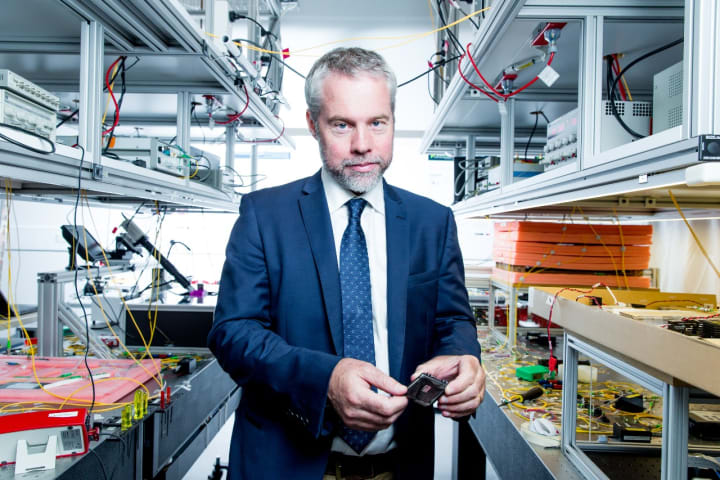Quantum Warriors: New Weapons from Spooky Physics
Scientists in Australia are plying the subatomic realm for a range of new defence applications.

EVEN WARFARE is going quantum: in Australia, researchers have started plying the subatomic realm for a range of possible defence applications that might well help the nation capture, or at least maintain, regional superiority in the sky, land and sea.
Most of the research is backed by the Australian Department of Defence’s ambitious Next Generation Technology Fund, managed by the Defence Science and Technology Group, an Australian research agency responsible for the development of emerging technologies for the military, which is spending A$730 million to upgrade Australia’s military might by pushing technologies hard in order to develop novel solutions to a range of battlefield challenges.
Of the 11 multi-year projects seeking to exploit the often-spooky effects of quantum mechanics, four are under development by the Institute for Photonics and Advanced Sensing (IPAS) at the University of Adelaide. Among them, quantum radar to detect stealth aircraft; portable atomic clocks for use in a battlefield when GPS is knocked out by an adversary; and a quantum magnetometer array for anti-submarine warfare.
Take quantum radar: stealth aircraft —like China’s Chengdu J-20 Black Eagle jet fighter — are designed with rounded surfaces or absorbent materials and other technologies that make them more difficult to detect or track effectively by conventional radar. Stealth planes are especially effective if used alongside radar jamming and other electronic countermeasures that try to saturate a defensive radar receiver with noise or false information on the range, angle or velocity of objects.
But quantum radar could overcome these barriers by using a beam of single entangled photons, sent one at a time. When the reflected photon is received back, it is compared with its entangled twin at the detector’s ‘idler beam’. The detector can then isolate just those photons that were originally sent by the radar, completely filtering out any other sources — making them hard to evade or confuse with jamming or electronic countermeasures.

Although the concept is still in its infancy, and there’s some loss of signal, enough quantum correlations should survive to make them effective. And it turns out that single photons, when they strike a target, behave very differently from the mass pulse microwave beams used in conventional radar.
“These small pulse signals actually interact with the airplane differently from large pulses, and you’re more likely that the photons reflect back to a detector,” said IPAS’s Dr Ben Sparkes. “So you get better sensitivity that way.
“Maybe it wouldn’t work like a standard radar, but more like a trip-wire that detects a suspect object at a predefined distance. You can then focus your conventional radar onto that region and try and measure the incoming object [in more detail].”
Another threat is losing access to the Global Positioning System, or GPS, run by the U.S. Air Force Space Command, which provides extremely accurate timing and frequency signals from a network of 31 satellites. Each satellite has two precision atomic clocks, accurate to within 100 billionths of a second, that are synchronised with each another. GPS receivers on the ground work by measuring the relative time delay between the signals from four satellites simultaneously, and then mathematically converting these into spatial coordinates to an accuracy of up to 30 cm. China, Russia and Europe have their own global constellations, and India a regional one.
Without GPS, targeting an enemy would be monstrously difficult in today’s fast-moving battlefront. But it’s not just essential in warfare: civilian financial networks, telecommunication networks and electrical power grids also rely on GPS for precision timing.
To compensate — for the military, at least — IPAS is developing smaller, lighter and highly accurate yet portable atomic clocks that could be used in the field for navigation, communications and targeting; one is quantum optical clock; the other, a cryogenic sapphire oscillator, or ‘sapphire clock’.
“That’s a really important area for Defence,” said Sparkes. “We’ve got two projects with slightly different clock designs, trying to make them maybe briefcase-sized, but also extremely accurate. Maybe not as good as the best room-sized atomic clocks, but not that much worse.”
For the quantum optical clock, IPAS believe they can boost accuracy 100-fold compared with current field-tested hydrogen maser clocks; with the sapphire clock, the aim is for 1,000 times better — only losing or gaining one second every 40 million years.
Submarines are another objective. Being undetectable is their shtick: they use quiet motors, have sound-absorbent cladding on the hull, hide or disperse heat exhaust, and are built with as few magnetic metals like iron, nickel and cobalt and most of their alloys as possible. Instruments like computers are shielded to dampen their electromagnetic fields, and everything inside that could possibly make noise is cushioned with rubber.
When approaching for attack, submarines can turn off just about everything — making them very hard to detect by acoustic sensors like hydrophones, especially in the noisier undersea environments near the coast.
But they can’t avoid being made of metal. And a slow-moving metal object underwater is just what a quantum magnetometer would excel at sniffing out.
These are envisioned as an array of tiny atomic detectors on the sea floor, connected by optical fibre to monitoring stations on land. Lasers are repeatedly fired down the line, triggering atoms in the sensor to light up and — using a quantum technique known as non-linear magneto-optical rotation — measure surrounding magnetic fields. As a large, slow-moving metal object passes near one of the detectors, its magnetic ‘shadow’ can then be seen and tracked.

“The great thing about these detectors is they have no power requirements, they’re just atoms in a glass cell,” added Sparkes. “Changes in the gradient of magnetic fields over a 2D array tells you something is passing by … [and] you work out what direction it’s moving as it crosses other detectors in the array.” What’s more, it’s especially sensitive at low frequencies, which is exactly what you want in a submarine detector, he added.
At the University of Sydney’s Jericho Smart Sensing Lab, researchers are working with the Air Force to develop sensors that measure the gravity gradients of surrounding topography and allow aircraft to navigate even if GPS has been jammed or degraded.
To do this, they plan to rely on gravity gradiometry, a technology used in civil engineering and mining to measure the density of underlying rock, making it possible to build a picture of topography and subsurface anomalies; airborne use relies on a cluster of gradiometers. But the problem with even the best gravity gradiometers is that they take time to build a map of the terrain; what’s more, they all rely on accelerometers measuring the displacement of a mass attached to a spring — a concept that hasn’t changed much in a century.
An entirely novel approach is to use a quantum-based gravity gradiometer, relying on the Nobel Prize-winning 1980s invention of the atom interferometer. Most interferometers are optical: they split light into two divergent paths and compare them at the end; when the beams recombine, they create patterns of light and dark bands called interference fringes, which give highly precise measurements of all sort of physical phenomena, from stars to molecules.
Atom interferometers work by coaxing atoms — which are highly sensitive to gravity — to behave like light waves. Pulsing lasers then split and manipulate atom waves to travel different paths, which interact with gravity in a way that affects the interference pattern produced when the two waves recombine. Scientists can then analyse this pattern to obtain an extraordinarily accurate measurement of surrounding gravitational fields.
“It turns out that an atom-based gravity gradient sensor is much more robust and accurate and precise, and requires less calibration,” said Prof. Ben Eggleton, director of Sydney Nano Institute where the Jericho Lab is based. “It’s a paradigm shift in gravity gradient sensors.”

The sensors rely on the fact that the gravity gradients of most of the Earth’s surface have already been mapped for mining or engineering purposes; so computers aboard the aircraft can then match terrain they see in real time with the maps. “So your gravity sensor will look around and tell the computer, ‘That’s a mountain over there, that’s hill over there, that’s as a bit of a gully’ and then the computer will say, ‘Ok, I know exactly where I am’,” added Eggleton.
The ambition is to not only develop a single instrument that does the job, but to meld it with all the other instrumentation on a plane — a concept known as ‘sensor fusion’. This especially important for a fighter pilot who’s dealing with the sensory overload of an airborne conflict, or commanders and tacticians on the ground who are handling multiple data streams.
“You combine all those different sensory outputs and create a map that informs you well beyond what you might be able to infer from just one or two of those sensors,” said added Eggleton. This would rely on artificial intelligence and machine learning to convert the raw data into valuable information that can be quickly understood and acted upon, he said.
“The Air Force is already using sensors all over the place, but many of them are 1990s technology that require a bunch of engineers staring at screens,” Eggleton added. “We hope to enable automation that provides a higher level of situational awareness — for the commander on the battlefield, chief of the Air Force or the prime minister — as it unfolds.”
Like this story? Please click the ♥︎ below, or send me a tip. And thanks 😊
About the Creator
Wilson da Silva
Wilson da Silva is a science journalist in Sydney | www.wilsondasilva.com | https://bit.ly/3kIF1SO






Comments
There are no comments for this story
Be the first to respond and start the conversation.